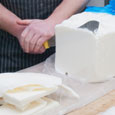Even when I'm too busy to cook I always scan my Dr Weil emails. I was surprised, maybe a little shocked, by todays email rethinking the health benefits of lard - really???
As I read it through, I realized that we need to be careful with our assumptions about health. Ideas shift with time. Science is not exact - it's a bundle of theories that rely on imperfect evidence - and interpretations of that evidence sometimes change.
There's been a clear shifting of ideas concerning health during my lifetime.
As we were raising our children in the 70s and 80s, sugar was the enemy. I remember being counseled to add a little more butter or oil to a baking recipe in order to decrease the sugar.
As our children were entering high school, our assumptions turned upside down and there was a new enemy - fat. We could eat about anything we wanted as long as it was labeled "fat free." Our diets were full of refined carbs and sugar - but we weren't eating any of that bad fat!
The came the Atkins revolution. Fat is OK and Protein is king. Carbs became the big enemy. We could eat bacon, eggs, and steak for breakfast! I will never forget sitting at breakfast in the South American country of Guyana. The buffet tables were dripping with gorgeous and delicious local fruits. But this couple filled their plates with bacon, eggs, meats and not one bite of fruit! I looked from my fresh colorful plate to theirs dripping in grease and just couldn't understand why someone would choose to eat like that. It didn't feel right.
We are still living under the "protein is king" assumption. Will it last? It seems like our ideas change about every 10 years - so we need to be wise and careful.
This is a long introduction to Dr Weil's article on lard - that might now be a healthy part of our diets!?!

In the minds of many people, lard is the most unhealthy food imaginable. The conventional wisdom of the last 40 years has been that saturated fats in our diets - that is, fats such as lard that are solid at room temperature - are a principal cause of high cholesterol and rising rates of heart disease.
However, those conclusions now seem to be based on rather shaky science. A more recent scientific analysis of 21 studies determined that there is no significant evidence thatdietary saturated fat is associated with an increased risk of coronary artery disease. Instead, the principal culprit in the obesity epidemic, and a major contributor to heart disease, appears to be overconsumption of sugars and carbohydrate-intensive foods.
Nutritionally speaking, lard has more than twice the monounsaturated fat of butter. It is also low in omega-6 fatty acids, known to promote inflammation. According to lard enthusiasts, free-range pigs that eat greens, not grains, have higher levels of omega-3 fatty acids.
Lard has always been prized as a cooking fat because it has a higher smoking point than other fats. For that reason, foods fried in lard absorb less grease. It also has the reputation of producing ultra-flaky pastry crust. For all of these reasons, lard has been making a comeback in high-end restaurants.
Avoid hydrogenated lard from supermarkets. The best lard is considered to be minimally processed "leaf lard" from the area around the pig's abdomen and kidneys or fatback lard from the pig's back. You can get this type at high-end specialty markets or online.
Should you eat lard? Consumption of animal foods raises ethical questions for many people. These concerns are an individual matter, and I won't presume to weigh in on this complex issue. However, particularly if the lard comes from free-range, organically raised pigs, I don't believe it is harmful to human health.
However, those conclusions now seem to be based on rather shaky science. A more recent scientific analysis of 21 studies determined that there is no significant evidence thatdietary saturated fat is associated with an increased risk of coronary artery disease. Instead, the principal culprit in the obesity epidemic, and a major contributor to heart disease, appears to be overconsumption of sugars and carbohydrate-intensive foods.
Nutritionally speaking, lard has more than twice the monounsaturated fat of butter. It is also low in omega-6 fatty acids, known to promote inflammation. According to lard enthusiasts, free-range pigs that eat greens, not grains, have higher levels of omega-3 fatty acids.
Lard has always been prized as a cooking fat because it has a higher smoking point than other fats. For that reason, foods fried in lard absorb less grease. It also has the reputation of producing ultra-flaky pastry crust. For all of these reasons, lard has been making a comeback in high-end restaurants.
Avoid hydrogenated lard from supermarkets. The best lard is considered to be minimally processed "leaf lard" from the area around the pig's abdomen and kidneys or fatback lard from the pig's back. You can get this type at high-end specialty markets or online.
Should you eat lard? Consumption of animal foods raises ethical questions for many people. These concerns are an individual matter, and I won't presume to weigh in on this complex issue. However, particularly if the lard comes from free-range, organically raised pigs, I don't believe it is harmful to human health.



